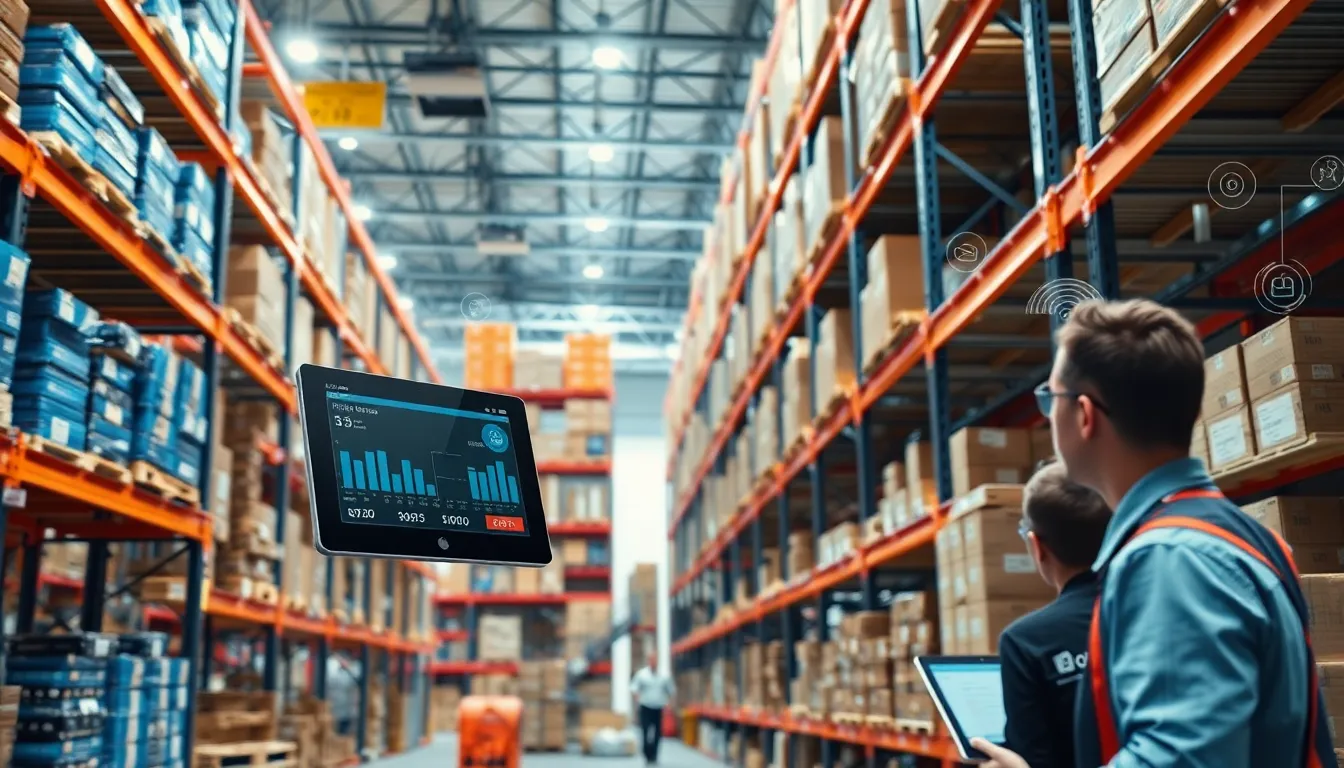Table of Contents
ToggleThe Internet of Things (IoT) is turning the supply chain into a high-tech playground where smart devices play nice with logistics. Imagine a world where your coffee maker knows when you’re running low on beans and orders a fresh batch before you even realize you need it. This isn’t just a caffeine dream; it’s the reality of IoT in the supply chain.
As businesses embrace this tech-savvy revolution, they’re not just improving efficiency—they’re redefining how products move from point A to point B. With real-time data and automation, the supply chain is becoming quicker, smarter, and a little more fun. Buckle up as we dive into how IoT is transforming the supply chain landscape and why it’s time for companies to join the digital party.
Overview of Internet of Things Supply Chain
The Internet of Things (IoT) drastically transforms the supply chain landscape. Smart devices enhance logistical operations by enabling seamless communication between assets. Businesses leverage real-time data for inventory management, which greatly reduces stockouts and overstock issues.
Automation plays a key role in this evolution. Sensors monitor conditions, ensuring optimal product quality during transportation. For instance, temperature and humidity sensors track perishable goods, maintaining freshness to prevent waste.
Connectivity among devices further streamlines processes. RFID tags and GPS technology facilitate accurate tracking of shipments. As a result, companies gain visibility into their supply chain operations, allowing timely decision-making.
Integration of IoT solutions improves efficiency. Automated systems handle routine tasks, freeing up human resources for strategic planning. Organizations reporting successful IoT implementations show increased productivity and reduced operational costs, reflecting a notable return on investment.
Challenges do exist, however. Security concerns about data breaches require robust protection measures. Maintaining standardization across various devices and platforms also presents integration hurdles. Despite these obstacles, the advantages of IoT in the supply chain outweigh potential drawbacks, driving widespread adoption.
Adopting IoT technologies not only enhances operational efficiency but also fosters innovation. Companies achieve growth by exploring new business models that leverage connected devices. In conclusion, IoT in the supply chain marks a significant leap toward a smarter, more responsive business environment.
Key Components of Internet of Things Supply Chain

The Internet of Things supply chain integrates various components that enhance operational efficiency and visibility.
Sensors and Devices
Sensors monitor conditions in real time. They track factors such as temperature and humidity, crucial for perishable goods. IoT devices automate tasks, signaling when stock levels drop or quality declines. Smart devices facilitate seamless communication between inventory and management systems, ensuring prompt actions for replenishment. Examples include RFID tags that provide precise location tracking of products. These technologies increase accuracy and reduce the chances of stockouts and overstock situations.
Connectivity and Communication Technologies
Connectivity forms the backbone of the IoT supply chain. Technologies like Wi-Fi, Bluetooth, and cellular networks enable devices to communicate effectively. These connections allow instantaneous data sharing among all elements in the supply chain. Applications utilize GPS technology to enhance visibility, offering real-time tracking of shipments. Businesses benefit from improved decision-making through timely updates on supply chain status. Moreover, strong connectivity increases efficiency by linking various stakeholders, from suppliers to consumers.
Data Analytics and Management
Data analytics transforms raw data into actionable insights. Advanced analytics tools process large volumes of data collected from IoT devices. Companies can identify trends, optimize inventory levels, and enhance demand forecasting through these insights. Effective management systems enable businesses to streamline operations and boost productivity. Additionally, predictive analytics allows organizations to anticipate issues before they arise. Insights gleaned from data shape strategic decisions and drive improvements across the supply chain.
Benefits of Implementing Internet of Things in Supply Chains
IoT implementation in supply chains provides substantial advantages. Businesses experience enhanced operations that lead to better decision-making.
Enhanced Efficiency
Enhanced efficiency arises from the automation of routine tasks. IoT devices streamline workflows, which reduces human error significantly. Companies benefit from real-time data that supports inventory management and optimizes transportation routes. Inventory levels adjust automatically, ensuring the right products are available at the right time. Research indicates that organizations adopting IoT solutions can boost productivity by up to 30%, translating to lower operational costs and increased profitability.
Improved Transparency
Improved transparency occurs through continuous data sharing across supply chain networks. Businesses gain visibility into every aspect, from manufacturing processes to delivery timelines. This connectivity fosters trust among stakeholders by providing accurate updates on product conditions and locations. Moreover, IoT data analytics allows companies to identify inefficiencies and rectify them quickly. Increased transparency enables organizations to respond proactively to market changes, enhancing customer satisfaction and loyalty.
Real-time Tracking and Monitoring
Real-time tracking and monitoring revolutionize logistics and supply chain management. With GPS and RFID technologies, assets can be monitored throughout their journey. Businesses gain insights into conditions affecting product quality, such as temperature and humidity, particularly for perishables. Continuous monitoring helps prevent losses and reduces waste, ensuring products arrive in optimal condition. Analysts suggest that real-time data can decrease delays by up to 50%, empowering companies to meet customer demands more efficiently.
Challenges in Internet of Things Supply Chain Implementation
Implementing IoT in the supply chain presents significant challenges that organizations must navigate to maximize benefits.
Security and Privacy Concerns
Security emerges as a primary concern for businesses integrating IoT into their supply chains. Every connected device represents a potential entry point for cyber-attacks, risking proprietary information and customer data. Data privacy regulations such as GDPR emphasize the need for robust security measures. Companies must routinely update their security protocols to safeguard against vulnerabilities. With the right encryption methods, organizations can enhance data protection across all devices. Furthermore, ongoing employee training regarding cybersecurity practices plays a crucial role in mitigating risks.
Integration with Existing Systems
Integrating IoT with existing systems poses considerable complexity for organizations. Legacy systems may not support modern IoT technology, complicating data interoperability. Communication between older hardware and new IoT solutions requires significant resources and time. Incompatibility can lead to disruptions in supply chain operations if left unaddressed. Ensuring seamless integration demands careful planning and thoughtful selection of compatible devices. Organizations benefit from assessing legacy infrastructure before implementation, facilitating smoother transitions.
Future Trends in Internet of Things Supply Chain
The future of the Internet of Things in supply chains showcases transformative advancements. Businesses increasingly leverage automation and artificial intelligence to streamline operations.
Automation and AI Integration
Automation enhances operational efficiency across the supply chain. Utilizing AI algorithms, companies predict demand patterns and optimize inventory levels. Machine learning aids in real-time data analysis, enabling quick adjustments to logistics strategies. Sensors integrated with AI monitor assets continuously, providing insights into performance and potential issues. This technology reduces human error, significantly boosting productivity. Research indicates organizations that adopt these solutions experience efficiency gains of over 30%. Companies that combine automation with AI drive innovation, creating more responsive supply chains.
Sustainable Supply Chain Practices
Sustainability becomes a focal point as IoT adoption grows. Smart devices monitor energy consumption and resource usage, allowing businesses to identify areas for improvement. Companies that implement IoT solutions reduce waste and carbon footprints. For instance, predictive analytics aids in optimizing routes, minimizing fuel consumption. Sustainable practices result in lower operational costs and compliance with environmental regulations. Organizations embracing these technologies attract eco-conscious consumers, enhancing brand loyalty. Reports suggest that businesses focusing on sustainability experience an increase in market competitiveness and customer engagement.
The Internet of Things is reshaping the supply chain landscape in profound ways. By integrating smart devices and real-time data, businesses are achieving unprecedented levels of efficiency and transparency. This digital transformation not only streamlines operations but also fosters innovation, allowing companies to adapt to changing market demands swiftly.
While challenges like security and compatibility remain, the benefits of IoT adoption far outweigh the hurdles. As organizations continue to embrace automation and AI, they position themselves for long-term success. Ultimately, the future of supply chains lies in harnessing the power of IoT to create a more agile and sustainable business environment.




